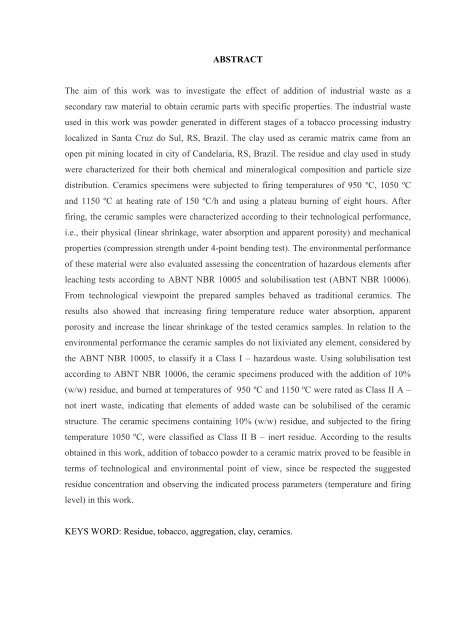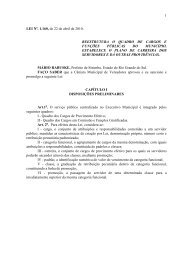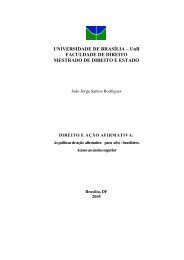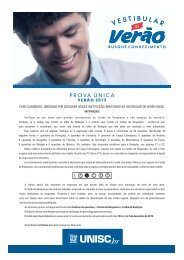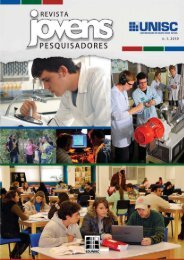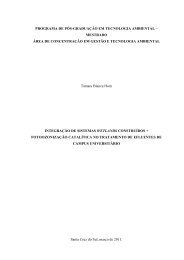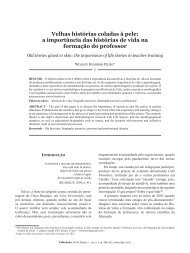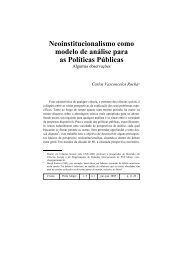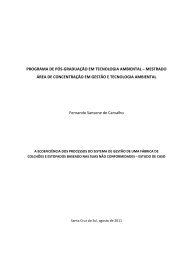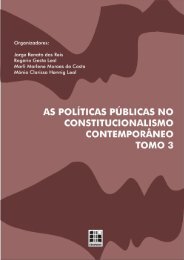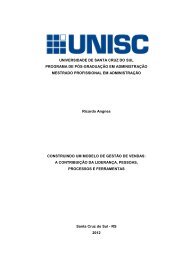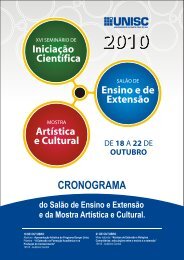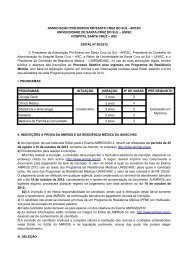Dissertação Daniel Brinckmann Teixeira - Unisc
Dissertação Daniel Brinckmann Teixeira - Unisc
Dissertação Daniel Brinckmann Teixeira - Unisc
You also want an ePaper? Increase the reach of your titles
YUMPU automatically turns print PDFs into web optimized ePapers that Google loves.
8<br />
ABSTRACT<br />
The aim of this work was to investigate the effect of addition of industrial waste as a<br />
secondary raw material to obtain ceramic parts with specific properties. The industrial waste<br />
used in this work was powder generated in different stages of a tobacco processing industry<br />
localized in Santa Cruz do Sul, RS, Brazil. The clay used as ceramic matrix came from an<br />
open pit mining located in city of Candelaria, RS, Brazil. The residue and clay used in study<br />
were characterized for their both chemical and mineralogical composition and particle size<br />
distribution. Ceramics specimens were subjected to firing temperatures of 950 ºC, 1050 ºC<br />
and 1150 ºC at heating rate of 150 ºC/h and using a plateau burning of eight hours. After<br />
firing, the ceramic samples were characterized according to their technological performance,<br />
i.e., their physical (linear shrinkage, water absorption and apparent porosity) and mechanical<br />
properties (compression strength under 4-point bending test). The environmental performance<br />
of these material were also evaluated assessing the concentration of hazardous elements after<br />
leaching tests according to ABNT NBR 10005 and solubilisation test (ABNT NBR 10006).<br />
From technological viewpoint the prepared samples behaved as traditional ceramics. The<br />
results also showed that increasing firing temperature reduce water absorption, apparent<br />
porosity and increase the linear shrinkage of the tested ceramics samples. In relation to the<br />
environmental performance the ceramic samples do not lixiviated any element, considered by<br />
the ABNT NBR 10005, to classify it a Class I – hazardous waste. Using solubilisation test<br />
according to ABNT NBR 10006, the ceramic specimens produced with the addition of 10%<br />
(w/w) residue, and burned at temperatures of 950 ºC and 1150 ºC were rated as Class II A –<br />
not inert waste, indicating that elements of added waste can be solubilised of the ceramic<br />
structure. The ceramic specimens containing 10% (w/w) residue, and subjected to the firing<br />
temperature 1050 ºC, were classified as Class II B – inert residue. According to the results<br />
obtained in this work, addition of tobacco powder to a ceramic matrix proved to be feasible in<br />
terms of technological and environmental point of view, since be respected the suggested<br />
residue concentration and observing the indicated process parameters (temperature and firing<br />
level) in this work.<br />
KEYS WORD: Residue, tobacco, aggregation, clay, ceramics.


